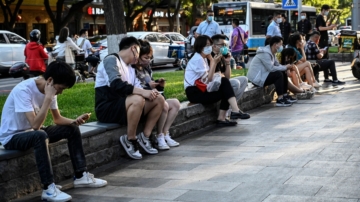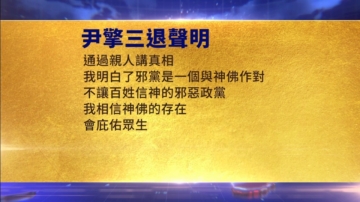【新唐人2013年12月18日讯】中国大陆的三峡工程,号称是世界上最大的水利工程,但遗留的问题众多,目前面临重重危机。日前,中共媒体针对外界普遍抨击的三峡工程,所带来的诸多弊端与危害,作了辩解,但立即遭到专家和民众们的吐槽和质疑。
日前,大陆各大门户网站,纷纷转载中共喉舌《新华网》的一篇有关三峡工程问题的文章,文中针对三峡工程带来的八大“焦点问题”一一作了辩解。
这八大问题包括:泥沙淤积埋大坝﹔地质灾害多发﹔蓄水诱发地震﹔高坝阻断环流路﹔两湖喊渴伏危机﹔珍稀物种面临灭绝﹔三峡大坝船闸把黄金水道拦腰截断,使得大批过坝船舶被迫长时间待闸﹔和坝下的河流,因泄洪冲刷岸坡变陡,“崩岸”现象日趋严重等。
针对上述问题,外界质疑,媒体避重就轻,列举有关管理部门采取的一些效果有限的应对措施,却回避问题带来的严重后果。
外界认为,虽然当局表面承认三峡工程存在的相关问题,但对三峡工程造成的实际危害,陈述时却尽量减轻程度或缩小范围,只字不提如果问题继续恶化可能带来的恶果。
据公开的资料显示,三峡工程在移民、生态环境、地质灾害等方面,引起的问题日趋严重。而专家们也注意到三峡工程所引发的诸多严重问题。
旅居德国的中国水利专家王维洛曾对媒体表示,三峡工程是中共尽力摁住的一个火药桶,随时可能爆发。
王维洛:“当年的黄万里先生有一个观点,说辛亥革命是从四川保路运动开始的,而三峡工程是中共政府花最大的钱尽力摁住的火药桶,这个火药桶很可能随时都会爆发。”
中国民间水专家张俊峰:“从我对三峡水库的认识来看,我觉得他在很短暂的时间之内,去把一个地质很脆弱的地区蓄满了水,这样一个作用的话,势必从生态系统,从整个的自然变化系统,相当于一个冲击。而这种冲击,一定会对自然体系造成其他的连锁的影响。”
最初兴建三峡工程的四个目标是:防洪、发电、航运、南水北调。但是最终只实现了一个目标,那就是发电。然而,三峡工程的电并没有照亮半个中国,目前三峡工程的发电量不足全中国发电量的百分之三。
中国环保活动人士戴晴:“那么,现在20多年过去了,我们看到防洪几乎是没有任何效果,基本上起的是碍航的作用,可能有(负责三峡)移民的官员从国家的拨款里得到了幸福,甚至于富起来了。将近200万移民没有幸福可言。”
而近年来,不断看到三峡工程给人们带来的后患。
2004年冬,荆江长江干堤发生多处崩岸﹔2006年春传来岳阳长江干堤发生严重崩岸,湖南省水利厅负责人紧急赴京向水利部和国家防总汇报险情。
此外,三峡地区仪器可测到的地震次数明显增加。虽然到现在为止还没有发生破坏性的地震,但是地震专家认为,三峡地区有可能发生六级或六点五级地震。
今年7月以来,中国南方上海、浙江、湖南、贵州等多个省份,至少超过40个城市,气温超过摄氏40度,其中,浙江省奉化市最高气温已经突破摄氏43度,连续一周蝉联中国“高温之冠”,老百姓叫苦连天。不少分析人士认为,高温与“三峡”大坝拦水和南水北调有关。
中国物理学教授钱伟长,早在1991年,就在报刊上撰文有关海湾战争和三峡大坝建设的安全关系。他说,三峡水库溃坝的危害,将使长江下游六省市成为泽国,几亿人将陷入绝境。
而时事评论员林子旭早前也对《新唐人》表示,中共耗钜资兴建的三峡工程,却是在三峡下游成千上万的民众头上,悬的一把随时可能落下来的闸刀。
采访编辑/常春 后制/李勇
Chinese State Media Defend Three Gorges Dam Disasters
China’s Three Gorges Dam is the world’s largest
hydropower project, and has faced many problems.
The Chinese Communist Party (CCP) has faced many
criticisms over disasters associated with the project.
State-controlled media recently published an article
defending the dam project, immediately drawing
further debate from environmentalists and experts.
Xinhua News Agency recently published an
article explaining CCP measures to target eight
common criticisms of the Three Gorges Dam.
The eight criticisms are;
reservoir sedimentation;
multiple geological disasters;
reservoir-induced seismic activity;
disrupting the Yangtze river system; drying up
of nearby lakes; extinction of rare species;
sluice gates blocking boat access; and
riverbank erosion causing landslides.
Xinhua’s article is criticized for ignoring the consequences,
by stating only the measures taken by the authorities.
The CCP regime acknowledged the disasters
associated with the Three Gorges Dam.
However, it argued that these consequential disasters
were avoided, and so the damage was minimized.
Public observations have indicated that the
Three Gorges Dam is a model for disasters.
It has displaced millions of people, and caused
environmental and geological devastation.
Water expert Wang Vero once described to media that
the Three Gorges Dam is like a barrel of gunpowder.
It could blow up at any time.
Wang Vero reflected on what
engineer Huang Wanli expressed.
The Railway Protection Movement in Sichuan
ignited the Chinese revolution in 1911.
The Three Gorges Dam, however, is a barrel
of gunpowder that the regime has spent a lot
of money to suppress consequential criticism.
Wang thinks it could blow up at any time.
Zhang Junfeng, environmentalist: “My understanding
of the Three Gorges Reservoir is that the weight of
water in the reservoir is sitting on a geologically fragile
region, and has a major impact on the entire ecosystem.
This will cause a serious chain reaction.”
The Three Gorges Dam was constructed
with four claims; that it would control floods,
generate power, and navigate and divert water.
So far, only one has been realized, that of power generation.
However, this generated power
did not illuminate half of China.
The power capacity of the dam covers less than
three percent of China’s energy requirements.
Dai Qing, environmentalist: “So now, 20 years later,
we see nearly a zero effect on flood mitigation.
It basically played the role of ‘water navigation interrupter’.
Officials may get rich and happy using the
budgets intended to be used to relocate residents.
The two million migrants do not have the same opportunity.”
People have faced much devastation in recent years,
as a direct consequence of the Three Gorges Dam.
In the winter of 2004, the riverbank collapsed at multiple
points along the Jing River dam, part of the Yangtze river.
In Spring 2006, a Hunan official
filed an emergency report in Beijing.
It referred to a severe collapse of parts of the riverbank
near a dam on the Yangtze River, in Hunan province.
In addition, significant increases in seismic activity
has been detected within the reservoir region.
There have been no major earthquakes, but experts
anticipate an quake of 6 or 6.5 on the Richter scale.
Since July this year, more than 40 cities in southern
China have experienced temperatures of over 40 degrees.
This includes Shanghai, as well as
cities in Zhejiang, Hunan, and Guizhou.
In particularly, Fenghua City of Zhejiang had
a record high of 43 degrees for a whole week.
This abnormality is believed to be associated
with the construction of the Three Gorges Dam
and the associated water diversion project.
Physicist Chien Wei-zang commented about the
safety of the Three Gorges Dam in a 1991 article.
He wrote that the collapse of the Three Gorges Dam
will bury six Provinces along the Yangtze River.
It would leave hundreds of millions of people in dire straits.
Commentator Lin Zixu has previously described to
NTD Television about the multi billion Yuan project.
Lin sees it as a guillotine the CCP regime has raised
above millions of Chinese peoples heads downstream.
Interview & Edit/Changchun Post-Production/LiYong
日前,大陆各大门户网站,纷纷转载中共喉舌《新华网》的一篇有关三峡工程问题的文章,文中针对三峡工程带来的八大“焦点问题”一一作了辩解。
这八大问题包括:泥沙淤积埋大坝﹔地质灾害多发﹔蓄水诱发地震﹔高坝阻断环流路﹔两湖喊渴伏危机﹔珍稀物种面临灭绝﹔三峡大坝船闸把黄金水道拦腰截断,使得大批过坝船舶被迫长时间待闸﹔和坝下的河流,因泄洪冲刷岸坡变陡,“崩岸”现象日趋严重等。
针对上述问题,外界质疑,媒体避重就轻,列举有关管理部门采取的一些效果有限的应对措施,却回避问题带来的严重后果。
外界认为,虽然当局表面承认三峡工程存在的相关问题,但对三峡工程造成的实际危害,陈述时却尽量减轻程度或缩小范围,只字不提如果问题继续恶化可能带来的恶果。
据公开的资料显示,三峡工程在移民、生态环境、地质灾害等方面,引起的问题日趋严重。而专家们也注意到三峡工程所引发的诸多严重问题。
旅居德国的中国水利专家王维洛曾对媒体表示,三峡工程是中共尽力摁住的一个火药桶,随时可能爆发。
王维洛:“当年的黄万里先生有一个观点,说辛亥革命是从四川保路运动开始的,而三峡工程是中共政府花最大的钱尽力摁住的火药桶,这个火药桶很可能随时都会爆发。”
中国民间水专家张俊峰:“从我对三峡水库的认识来看,我觉得他在很短暂的时间之内,去把一个地质很脆弱的地区蓄满了水,这样一个作用的话,势必从生态系统,从整个的自然变化系统,相当于一个冲击。而这种冲击,一定会对自然体系造成其他的连锁的影响。”
最初兴建三峡工程的四个目标是:防洪、发电、航运、南水北调。但是最终只实现了一个目标,那就是发电。然而,三峡工程的电并没有照亮半个中国,目前三峡工程的发电量不足全中国发电量的百分之三。
中国环保活动人士戴晴:“那么,现在20多年过去了,我们看到防洪几乎是没有任何效果,基本上起的是碍航的作用,可能有(负责三峡)移民的官员从国家的拨款里得到了幸福,甚至于富起来了。将近200万移民没有幸福可言。”
而近年来,不断看到三峡工程给人们带来的后患。
2004年冬,荆江长江干堤发生多处崩岸﹔2006年春传来岳阳长江干堤发生严重崩岸,湖南省水利厅负责人紧急赴京向水利部和国家防总汇报险情。
此外,三峡地区仪器可测到的地震次数明显增加。虽然到现在为止还没有发生破坏性的地震,但是地震专家认为,三峡地区有可能发生六级或六点五级地震。
今年7月以来,中国南方上海、浙江、湖南、贵州等多个省份,至少超过40个城市,气温超过摄氏40度,其中,浙江省奉化市最高气温已经突破摄氏43度,连续一周蝉联中国“高温之冠”,老百姓叫苦连天。不少分析人士认为,高温与“三峡”大坝拦水和南水北调有关。
中国物理学教授钱伟长,早在1991年,就在报刊上撰文有关海湾战争和三峡大坝建设的安全关系。他说,三峡水库溃坝的危害,将使长江下游六省市成为泽国,几亿人将陷入绝境。
而时事评论员林子旭早前也对《新唐人》表示,中共耗钜资兴建的三峡工程,却是在三峡下游成千上万的民众头上,悬的一把随时可能落下来的闸刀。
采访编辑/常春 后制/李勇
Chinese State Media Defend Three Gorges Dam Disasters
China’s Three Gorges Dam is the world’s largest
hydropower project, and has faced many problems.
The Chinese Communist Party (CCP) has faced many
criticisms over disasters associated with the project.
State-controlled media recently published an article
defending the dam project, immediately drawing
further debate from environmentalists and experts.
Xinhua News Agency recently published an
article explaining CCP measures to target eight
common criticisms of the Three Gorges Dam.
The eight criticisms are;
reservoir sedimentation;
multiple geological disasters;
reservoir-induced seismic activity;
disrupting the Yangtze river system; drying up
of nearby lakes; extinction of rare species;
sluice gates blocking boat access; and
riverbank erosion causing landslides.
Xinhua’s article is criticized for ignoring the consequences,
by stating only the measures taken by the authorities.
The CCP regime acknowledged the disasters
associated with the Three Gorges Dam.
However, it argued that these consequential disasters
were avoided, and so the damage was minimized.
Public observations have indicated that the
Three Gorges Dam is a model for disasters.
It has displaced millions of people, and caused
environmental and geological devastation.
Water expert Wang Vero once described to media that
the Three Gorges Dam is like a barrel of gunpowder.
It could blow up at any time.
Wang Vero reflected on what
engineer Huang Wanli expressed.
The Railway Protection Movement in Sichuan
ignited the Chinese revolution in 1911.
The Three Gorges Dam, however, is a barrel
of gunpowder that the regime has spent a lot
of money to suppress consequential criticism.
Wang thinks it could blow up at any time.
Zhang Junfeng, environmentalist: “My understanding
of the Three Gorges Reservoir is that the weight of
water in the reservoir is sitting on a geologically fragile
region, and has a major impact on the entire ecosystem.
This will cause a serious chain reaction.”
The Three Gorges Dam was constructed
with four claims; that it would control floods,
generate power, and navigate and divert water.
So far, only one has been realized, that of power generation.
However, this generated power
did not illuminate half of China.
The power capacity of the dam covers less than
three percent of China’s energy requirements.
Dai Qing, environmentalist: “So now, 20 years later,
we see nearly a zero effect on flood mitigation.
It basically played the role of ‘water navigation interrupter’.
Officials may get rich and happy using the
budgets intended to be used to relocate residents.
The two million migrants do not have the same opportunity.”
People have faced much devastation in recent years,
as a direct consequence of the Three Gorges Dam.
In the winter of 2004, the riverbank collapsed at multiple
points along the Jing River dam, part of the Yangtze river.
In Spring 2006, a Hunan official
filed an emergency report in Beijing.
It referred to a severe collapse of parts of the riverbank
near a dam on the Yangtze River, in Hunan province.
In addition, significant increases in seismic activity
has been detected within the reservoir region.
There have been no major earthquakes, but experts
anticipate an quake of 6 or 6.5 on the Richter scale.
Since July this year, more than 40 cities in southern
China have experienced temperatures of over 40 degrees.
This includes Shanghai, as well as
cities in Zhejiang, Hunan, and Guizhou.
In particularly, Fenghua City of Zhejiang had
a record high of 43 degrees for a whole week.
This abnormality is believed to be associated
with the construction of the Three Gorges Dam
and the associated water diversion project.
Physicist Chien Wei-zang commented about the
safety of the Three Gorges Dam in a 1991 article.
He wrote that the collapse of the Three Gorges Dam
will bury six Provinces along the Yangtze River.
It would leave hundreds of millions of people in dire straits.
Commentator Lin Zixu has previously described to
NTD Television about the multi billion Yuan project.
Lin sees it as a guillotine the CCP regime has raised
above millions of Chinese peoples heads downstream.
Interview & Edit/Changchun Post-Production/LiYong








